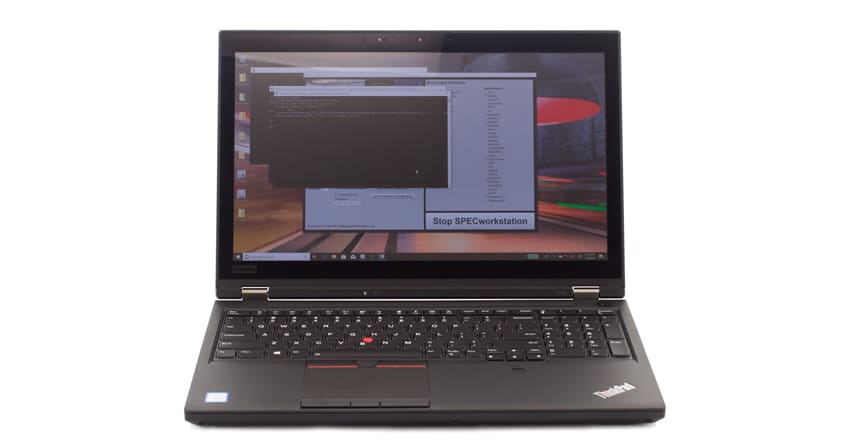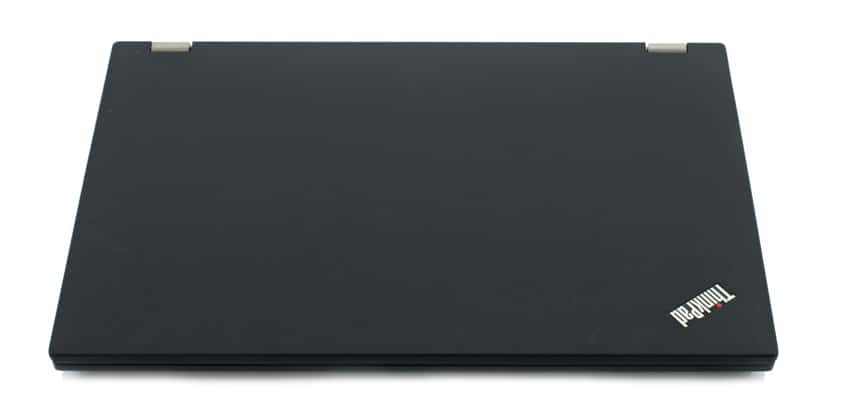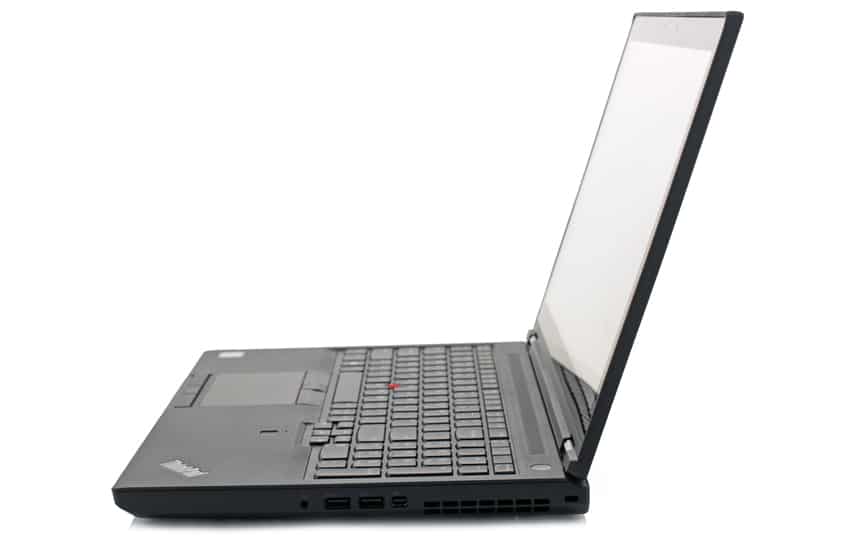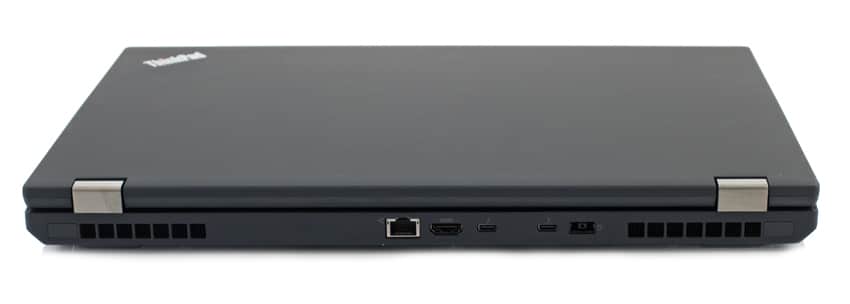
The Lenovo ThinkPad P52 is a performance-driven mobile workstation that features NVIDIA Quadro graphics and is ideal for engineers, designers, and prosumers looking for a powerful, yet compact, laptop. Lenovo also indicates that it is a VR-ready device. It also features a ton of connectivity including three USB 3.1 gen 1 ports, two USB 3.1 Gen 2 Type-C ports, Intel Thunderbolt 3 (Power Delivery, DisplayPort, Data Transfer), and an HDMI 2.0 port. For those on-the-go professionals who find themselves in areas without Wi-Fi, the P52 comes with the option of having 4G-LTE, which can sync with mobile provider plans.

The ThinkPad P52 is highlighted by its powerful components. For example, users have the option to equip the P52 with an 8th Generation Intel Core (up to an i7-8850H 6 core processor at 2.60GHz, up to 4.30GHz with TurboBoost) or Intel Xeon processors (up to an E-2176M 6-core processor at 2.70GHz, up to 4.40GHz with TurboBoost). All processors feature vPro, which is an Intel technology that provides hardware-enhanced security, remote manageability, flexible stability and productivity-enhancing capabilities. The P52 can also be outfitted with upwards of a whopping 128GB of DDR4 RAM, making it an ideal rig for those doing a lot of heavy designing. The compliment these components, users can also add up to 4TB of PCIe storage, though users can choose a 1TB 7200 RPM or 2TB 5400 RPM HDD if they don’t need the hard drive speed.
Security features are also abundant with the new Lenovo Thinkpad, as it encrypts its data with Trusted Platform Module (TPM) and features a match-on-chip fingerprint reader and facial login via the optional IR camera and Windows Hello.
If you’re willing to spend a bit more, the P52 offers 15.6-inch 4k UHD (3840 x 2160) touchscreen display, which features brilliant colors and 100% Adobe color gamut and 400 nit. For those looking for a more affordable option, users can go the FHD route, which features the usual a 1920 x 1080 resolution with 300 nit. The P52 also supports USB-C Thunderbolt 3, so users can connect and access devices quickly including high-resolution displays and high-performance data solutions.
For our particular build we used configured the P52 with 2.6 GHz Intel Core i7-8850H 6-Core CPU, 16GB of 2400 MHz DDR4, a NVIDIA Quadro P3200 with 6 GB GDDR5 vRAM GPU, 512GB NVMe M.2 SSD, and 1TB SATA 2.5″ HDD.
Lenovo ThinkPad P52 Specifications
| Processor | Up to 8th Generation Intel Core i7-8850H 6 core processor with vPro (2.60GHz, Up to 4.30GHz with Turbo Boost Technology, 9MB Cache) Intel Xeon E-2176M 6 core processor with vPro (2.70GHz, up to 4.40GHz with Turbo Boost Technology, 12MB Cache) |
| Operating System | Windows 10 Home Windows 10 Pro – Lenovo recommends Windows 10 Pro Windows 10 Pro for Workstations (available for Xeon processors) |
| Display |
15.6” FHD (1920 x 1080), 300nits, IPS anti-glare, 72% color gamut
15.6” UHD 4K (3840 x 2160), 400nits, IPS multi-touch, 100% Adobe color gamut
|
| Graphics | Up to NVIDIA Quadro P3200 6 GB |
| Camera | 720p HD Camera with dual array microphone and ThinkShutter Optional Infrared (IR) camera (required for facial login with Windows Hello) *ThinkShutter is not available on models with the IR Camera |
| Memory | Up to 128 GB DDR4 2400 MHz Up to 64 GB DDR4 2400 MHz ECC (available for Xeon processor) |
| Storage | Up to 1 TB 7200 RPM 2 TB 5400 RPM Up to 2 TB PCIe SSD |
| Battery | Up to 10 hours, 6 cell, 90 Whr |
| Power Supply Unit | Adapter 170 W |
| Audio | Dolby Atmos for headset |
| Security | Trusted Platform Module (TPM) 2.0 Optional IR camera (for login with Windows Hello) Match-on-chip fingerprint reader ThinkShutter privacy cover (not available with IR Camera) Kensington lock slot |
| I/O (Input / Output) Ports | 3 x USB 3.1 Gen 1 2 x USB 3.1 Gen 2 Type-C / Intel Thunderbolt 3 (Power Delivery, DisplayPort, Data Transfer) HDMI 2.0 4-in-1 card reader (SD, SDHC, SDXC, MMC) Headphone/mic combo jack Mini DisplayPort 1.4 Smart card reader (optional) RJ45 Gigabit Ethernet |
| Connectivity |
WLAN: Intel Dual Band 9560 Wireless AC (2 x 2) with vPro + Bluetooth 5.0
WWAN
Fibocom L850-GL 4G LTE-A cat 9 (optional) |
| Dimensions (W x D x H) | 14.86” x 9.93” x 0.96” / 377.4 x 252.3 x 24.5 (mm) |
| Weight | Starting at 5.4 lbs (2.45 kg) |
| Keyboard |
Spill resistant
105 keys plus numeric pad
Backlit with white LED lighting
ISV Certifications
|
Design and build
For the amount of power it offers, the P52 is a pretty compact device. At top of the screen is the webcam, which features an integrated privacy cover to ensure that it’s only used when it’s supposed to be used.
On the right side is the Combo audio/mic port, two USB 3.1 ports, a Mini DisplayPort and a Kensington lock slot. The left side has a USB 3.1 port (with power delivery), a 4-in-1 card reader (supports SD, SDHC, SDXC, MMC form factors), and a Smart card reader (an optional feature).
Lastly, on the back, is the J45 port, an HDMI 2.0 port, the USB-C Thunderbolt 3 port and the charger port.
Performance
To find out what the Lenovo P52 is made of, we put it through three resource-intensive tests. These tests will also show the capabilities of the Quadro P2000 when inside the Precision 5530. We’ve also compared it to the following workstations:
This first test is the SPECviewperf 12 benchmark, which is the worldwide standard for measuring graphics performance based on professional applications. SPECviewperf runs 9 benchmarks called “viewsets,” which represent graphics content and behavior from actual applications and include categories such as 3D Max, CATIA, Creo, Energy, Maya, Medical, Showcase, Siemens NX, and Solidworks.
| SPECviewperf 12 | ||
|---|---|---|
| Viewsets | ThinkPad P72 | ThinkPad P52 |
| 3dsmax-06 | 153.14 | 122.51 |
| Catia-05 | 252.76 | 200.53 |
| Creo-02 | 222.95 | 173.14 |
| Energy-02 | 35.65 | 24.3 |
| Maya-05 | 232.12 | 175.75 |
| Medical-02 | 55.51 | 39.35 |
| Showcase-02 | 70.38 | 51.57 |
| Snx-03 | 344.37 | 241.65 |
| Sw-04 | 156.88 | 134.04 |
As you can see, the Lenovo P52 recorded very impressive results. However, unsurprisingly not as powerful as its bigger sibling.
Additionally, we also ran SPECworkstation3, which is a specialized benchmark designed for testing all key aspects of workstation performance; it uses over 30 workloads to test CPU, graphics, I/O, and memory bandwidth. The workloads fall into broader categories such as Media and Entertainment, Financial Services, Product Development, Energy, Life Sciences, and General Operations. We are going to list the broad-category results for each, as opposed to the individual workloads. The results are an average of all the individual workloads in each category.
| SPECworkstation3 | ||
|---|---|---|
| Category | ThinkPad P72 | ThinkPad P52 |
| M&E | 1.93 | 1.78 |
| ProdDev | 1.82 | 1.76 |
| LifeSci | 1.61 | 1.42 |
| Energy | 1.18 | 1.04 |
| FSI | 1.58 | 1.17 |
| GeneralOps | 1.46 | 1.7 |
| GPU Compute | 2.53 | 1.9 |
Here, the P52 fell a bit behind the P72, but only slightly.
Next up is the Environmental Systems Research Institute (Esri) benchmark. Esri is a supplier of Geographic Information System (GIS) software. Esri’s Performance Team designed their PerfTool add-in scripts to automatically launch the ArcGIS Pro. This application uses a “ZoomToBookmarks” function to browse various pre-defined bookmarks and create a log file with all the key data points required to predict the user experience. The script automatically loops the bookmarks three times to account for caching (memory and disk cache). In other words, this benchmark simulates heavy graphical use that one might see through Esri’s ArcGIS Pro software.
The tests consist of three main datasets. Two are 3-D city views of Philadelphia, PA and Montreal, QC. These city views contain textured 3-D multipatch buildings draped on a terrain model and draped aerial images. The third dataset is a 2-D map view of the Portland, OR region. This data contains detailed information for roads, landuse parcels, parks and schools, rivers, lakes, and hillshaded terrain.
Looking at drawtime of the Montreal model, the Lenovo ThinkPad P52 showed an average drawtime of 00:01:30.973, while average and minimum FPS showed 125.4 and 59.78, respectively.
| ESRI ArcGIS Pro 2.3 Montreal | |
|---|---|
| Drawtime | Average |
| ThinkPad P72 | 00:01:31.638 |
| ThinkPad P52 | 00:01:30.973 |
| Average FPS | Average |
| ThinkPad P72 | 189.05 |
| ThinkPad P52 | 125.4 |
| Minimum FPS | Average |
| ThinkPad P72 | 83.02 |
| ThinkPad P52 | 59.78 |
Next up is our Philly model, where the ThinkPad P52 showed an average drawtime of 00:01:01.357, while average and minimum FPS showed 172.26 and 91.17, respectively.
| ESRI ArcGIS Pro 2.3 Philly | |
|---|---|
| Drawtime | Average |
| ThinkPad P72 | 00:01:01.079 |
| ThinkPad P52 | 00:01:01.357 |
| Average FPS | Average |
| ThinkPad P72 | 248.3 |
| ThinkPad P52 | 172.26 |
| Minimum FPS | Average |
| ThinkPad P72 | 114.32 |
| ThinkPad P52 | 91.17 |
Our last model is of Portland. Here, the P75 had an average drawtime of 00:00:32.234. Average FPS showed 1,512.37 while Minimum FPS showed 602.41.
| ESRI ArcGIS Pro 2.3 Portland | |
|---|---|
| Drawtime | Average |
| ThinkPad P72 | 00:00:32.196 |
| ThinkPad P52 | 00:00:32.234 |
| Average FPS | Average |
| ThinkPad P72 | 1,921.69 |
| ThinkPad P52 | 1,512.37 |
| Minimum FPS | Average |
| ThinkPad P72 | 763.11 |
| ThinkPad P52 | 602.41 |
Conclusion
The Lenovo ThinkPad P52 is a mid-sized mobile workstation with some impressive capabilities given what it can pack under its hood. Users can equip with workstation with either an 8th Generation Intel Core CPU or an Intel Xeon CPU, up to 128GB of DDR4 RAM, and up to 4TB of PCIe storage. The workstation comes with ample connectivity with 5 USB ports (including 2 USB-C or Thunderbolt 3 ports), an HDMI port, a 4-in-1 card reader, a Mini DisplayPort, and an RJ45 Gigabit Ethernet port. There is an optional 15.6-inch 4k UHD touchscreen display for users that would like the option of tablet like operability. Those looking not to break the bank can outfit the Lenovo workstation with HDDs, less RAM and an 8th Generation Intel Core CPU.
We tested the workstation using our graphics-intensive SPECviewperf, SPECworkstation3, and ESRI benchmarks. We compared the Lenovo P52 to its larger sibling the P72. This was a less of which is better (the P72 is outfitted with better hardware) and more of what one can expect when deciding which workstation to purchase. That being said, the P52 didn’t trail too far from the more powerful P72 in most of our testing.
Overall, the P52 is a powerful mobile workstation that can suit the needs of most users. The workstation provides enough power for some of the most graphically demanding workloads while remaining relatively compact.
Sign up for the StorageReview newsletter



